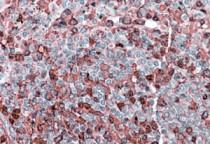ARG65024
anti-NFATc2 / NFAT1 antibody
anti-NFATc2 / NFAT1 antibody for IHC-Formalin-fixed paraffin-embedded sections,Western blot and Human
Cancer antibody; Cell Biology and Cellular Response antibody; Gene Regulation antibody; Immune System antibody; Metabolism antibody; Signaling Transduction antibody
Overview
| Product Description | Goat Polyclonal antibody recognizes NFATc2 / NFAT1 |
|---|---|
| Tested Reactivity | Hu |
| Predict Reactivity | Ms, Rat, Cow, Dog |
| Tested Application | IHC-P, WB |
| Specificity | This antibody is expected to recognize all three reported isoforms (NP_036472.2; NP_775114.1; NP_001129493.1). |
| Host | Goat |
| Clonality | Polyclonal |
| Isotype | IgG |
| Target Name | NFATc2 / NFAT1 |
| Antigen Species | Human |
| Immunogen | C-QQFRTGLSSPDARYQ |
| Conjugation | Un-conjugated |
| Alternate Names | NFATc2; NFATP; NFAT1; NFAT pre-existing subunit; NF-ATc2; T-cell transcription factor NFAT1; Nuclear factor of activated T-cells, cytoplasmic 2; NF-ATp |
Application Instructions
| Application Suggestion |
|
||||||
|---|---|---|---|---|---|---|---|
| Application Note | IHC-P: Antigen Retrieval: Steam tissue section in Citrate buffer (pH 6.0). WB: Recommend incubate at RT for 1h. * The dilutions indicate recommended starting dilutions and the optimal dilutions or concentrations should be determined by the scientist. |
Properties
| Form | Liquid |
|---|---|
| Purification | Purified from goat serum by antigen affinity chromatography. |
| Buffer | Tris saline (pH 7.3), 0.02% Sodium azide and 0.5% BSA. |
| Preservative | 0.02% Sodium azide |
| Stabilizer | 0.5% BSA |
| Concentration | 0.5 mg/ml |
| Storage Instruction | For continuous use, store undiluted antibody at 2-8°C for up to a week. For long-term storage, aliquot and store at -20°C or below. Storage in frost free freezers is not recommended. Avoid repeated freeze/thaw cycles. Suggest spin the vial prior to opening. The antibody solution should be gently mixed before use. |
| Note | For laboratory research only, not for drug, diagnostic or other use. |
Bioinformation
| Database Links |
Swiss-port # Q13469 Human Nuclear factor of activated T-cells, cytoplasmic 2 |
|---|---|
| Background | This gene is a member of the nuclear factor of activated T cells (NFAT) family. The product of this gene is a DNA-binding protein with a REL-homology region (RHR) and an NFAT-homology region (NHR). This protein is present in the cytosol and only translocates to the nucleus upon T cell receptor (TCR) stimulation, where it becomes a member of the nuclear factors of activated T cells transcription complex. This complex plays a central role in inducing gene transcription during the immune response. Alternate transcriptional splice variants encoding different isoforms have been characterized. [provided by RefSeq, Apr 2012] |
| Research Area | Cancer antibody; Cell Biology and Cellular Response antibody; Gene Regulation antibody; Immune System antibody; Metabolism antibody; Signaling Transduction antibody |
| Calculated MW | 100 kDa |
| PTM | In resting cells, phosphorylated by NFATC-kinase on at least 18 sites in the 99-363 region. Upon cell stimulation, all these sites except Ser-243 are dephosphorylated by calcineurin. Dephosphorylation induces a conformational change that simultaneously exposes an NLS and masks an NES, which results in nuclear localization. Simultaneously, Ser-53 or Ser-56 is phosphorylated; which is required for full transcriptional activity. Ubiquitinated in endothelial cells by RNF213 downstream of the non-canonical Wnt signaling pathway, leading to its degradation by the proteasome. |
Images (2) Click the Picture to Zoom In
-
ARG65024 anti-NFATc2 / NFAT1 antibody WB image
Western blot: MOLT4 lysate (35 µg protein in RIPA buffer) stained with ARG65024 anti-NFATc2 / NFAT1 antibody at 0.3 µg/ml dilution.
-
ARG65024 anti-NFATc2 / NFAT1 antibody IHC-P image
Immunohistochemistry: Paraffin embedded Human Spleen. (Steamed antigen retrieval with citrate buffer pH 6) stained with ARG65024 anti-NFATc2 / NFAT1 antibody at 3.8 µg/ml dilution followed by AP-staining.







